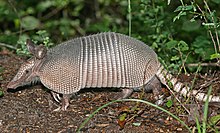
Cingulata is an order of armored placental mammals. Members of this order are called cingulates, or colloquially, armadillos. They are primarily found in South America, though the northern naked-tailed armadillo is found mainly in Central America and the nine-banded armadillo has a range extending into North America. They are generally found in forests, but also savannas, shrublands, and grasslands. They all follow a similar body plan, and range in size from the pink fairy armadillo, at 11 cm (4 in) plus a 2 cm (1 in) tail, to the giant armadillo, at 100 cm (39 in) plus a 50 cm (20 in) tail. No population estimates have been made for any cingulate species, though the giant armadillo and the Brazilian three-banded armadillo are categorized as vulnerable species.
The twenty-two extant species of Cingulata are divided into two families: Dasypodidae, containing a single genus of nine species in the subfamily Dasypodinae, and Chlamyphoridae, containing thirteen species split between the two genera in the subfamily Chlamyphorinae, three in the subfamily Euphractinae, and three in the subfamily Tolypeutinae. Prior to 2016, all four subfamilies were included in Dasypodidae, with Chlamyphoridae containing only extinct species of glyptodonts.[1][2] Over one hundred extinct Cingulata species have been discovered, though due to ongoing research and discoveries the exact number and categorization is not fixed.[3]